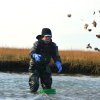It has been 50 years since Congress enacted a landmark piece of environmental legislation – the 1972 Clean Water Act. This bill was passed in response to the decrepit conditions of our nation’s waterways resulting from decades of irresponsible management of municipal, industrial and agricultural wastes.
We’ve made tremendous strides since the passage of this historic and far-reaching environmental legislation. As a direct result of the CWA, numerous programs have been developed within the Department of Natural Resources and Environmental Control designed to monitor, assess, improve and protect the health of Delaware’s waters – our most precious natural resource.
Prior to the CWA, wastewater discharges to Delaware’s surface waters were largely unpermitted and unmonitored. However, through the establishment of the National Pollutant Discharges Elimination System Program, the CWA built the statutory framework to enact controls over point source pollution and decrease pollutant discharges to surface water in Delaware and across the country. Through strict pollution reduction requirements and other permit restrictions, point source discharges have decreased in Delaware from nearly 200 facilities during the inception of Delaware’s program to just 39 industrial and municipal dischargers, 16 of which are stormwater only.
The job is not done, but building on the previous successes, the NPDES program continues to expand protection in other areas such as addressing municipal stormwater, livestock operations, industrial stormwater discharges and aquatic pesticide application.
Nonpoint source pollution, polluted stormwater runoff associated with rainfall, snowmelt, or irrigation moving over and through the ground, also threatens Delaware’s environment and public health. As this water moves, it picks up and carries pollutants with it, ultimately reaching waterbodies and groundwaters. Unfortunately, unlike point source pollution, NPS pollution often cannot be traced to a singular source and sometimes it cannot be traced at all. Often this type of pollution is associated with a variety of activities on the land, including farming, construction runoff, and streambank degradation.
Amendments to the CWA established the Section 319 NPS Management Program to address the need for greater federal leadership to help focus state and local NPS efforts. On Aug. 4, 1988, Delaware’s original NPS Pollution Management Program was approved by the EPA, making it one of the first programs in the nation to comply with Section 319 of the CWA. Delaware has been a leader in addressing NPS pollution since.
Some tools used in the state are regulatory; however, the vast majority are voluntary programs that have resulted in real water quality improvements. One long-standing example is Delaware’s cover crop program where farmers are provided incentives to plant crops over winter to slow erosion and take up nutrients, and more recently the Tree for Every Delawarean Initiative, which helps plant trees across the state to improve air and water quality.
Collectively, these efforts have resulted in significant water quality improvements as identified by the Department’s Water Quality Assessment Program. This program monitors water quality at more than 140 water quality stations throughout the state, and routinely samples for a suite of 31 physical, chemical, and biological parameters to ensure that Delaware’s waters meet water quality standards for the protection of aquatic life and human health.
Over the past several decades, monitoring results show decreasing levels of pollutants in water bodies throughout the state. Examples of these successful efforts are: the elimination of legacy industrial zinc sources from the Red Clay Creek; the elimination of impacts from point-source pollution discharging into the Inland Bays, the most recent and significant being the Rehoboth Wastewater Treatment Plant in 2018; the use of innovative technologies like dispersing activated carbon pellets throughout the waterbody to dramatically reduce contaminant levels in sediment and fish tissue in Mirror Lake (Dover); and the declining levels of toxic contaminants in fish tissue in waterbodies sampled throughout the state. The challenges are many as new emerging contaminants like per- and polyfluoroalkyl substances – known as PFAS – are discovered, and DNREC staff will continue to assess and protect Delaware’s waters.
While many challenges have been resolved and numerous success stories can be shared, all attributed to the passage of the groundbreaking CWA legislation, DNREC will not cease in our commitment to protect and improve Delaware’s waters. As we face the challenges of climate change and uplifting overburdened communities, we will continue this journey with our trusted nonprofit partners, the General Assembly, and all levels of government implementing the Clean Water Initiative for Underserved Communities and the Delaware Clean Water Trust, and investing millions of dollars to protect Delaware’s most precious resource.






















































